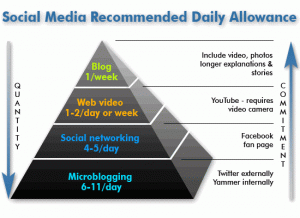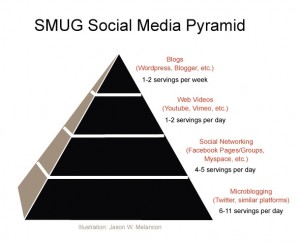Last week I introduced the concept of the SMUG Social Media Pyramid as a helpful framework for considering how much is “enough” in social media. It was an attempt to answer the question, “Should we spread our efforts over lots of platforms, of just focus on one or two?”
I followed that post with a couple of more, on portions and serving sizes, as well as the need to serve through your servings, and I appreciate all the supportive comments and re-tweets, as having an analogy to the balanced physical diet seemed to resonate with many people. Just as you have different “food groups” that contribute to overall health, various categories of social media tools meet different needs in communications.
But I wanted to spend a little time discussing one of the comments that, while supportive of the concept, raised an interesting issue:
I have to say, however, that from my perspective, none of what you describe constitutes strategy. It comes across like a hardware salesperson from the Snap-On Tool Company laying out tools, and telling us what tools are most important…WITHOUT KNOWING WHAT THE TOOLS WILL BE USED FOR!
In other words, the tools will be ranked very differently in order of importance if I’m working on a car engine than if I’m working on a water main. In the networked world, the operations we perform, the needs we express, vary immensely. From breaking a new music act to the bonding of parents with hydrocephalic children, to (as one of the commentors above mentions, connecting with old classmates.)
Not being negative here, Lee, just constructively critical. Here’s another thing to consider in ranking the relevance of the various social media platforms:
Existing content.
If, for example you’ve got a vault of video related to your subject, or if there’s some incredibly emotional and compelling content available on video, then You Tube (or Vimeo or Hulu or Veoh– each has its own strengths, and merits its own ranking-within-ranking) can become the foundational platform, and the other platforms will be implemented to drive awareness and patronage.
I don’t really disagree with much of what Bonifer had to say, except that what I’m presenting in the Social Media Pyramid is a “well-balanced diet” — or since it’s about production instead of consumption — a well-balanced menu. I’m not ranking the tools any more than the USDA is saying Breads, Cereal, Pasta and Rice are more important than Fruits or Vegetables.
I would say, however, that in most cases your program won’t reach its peak potential without a blog. Most of the content can be embedded video, or you may want to use primarily text-based posts. But a blog, like the one Bonifer mentioned, can be the hub to tie various tools together. And the blog he cited is actually a really good example of text, photos, a Twitter widget and embedded video. A blog gives you the potential for depth that you don’t have with other platforms.
The other good point Bonifer makes is that within each category of the pyramid, there are various options. In social networks, for example, you probably don’t need to have a major presence in Facebook and MySpace and LinkedIn and Orkut. You’ll probably pick just one, based on where members of the community you’re gathering spend their time. Or you may try to create your own special-purpose network with Ning or some other service.
And that relates back to the question that originally prompted me to publish the pyramid paradigm (I just can’t avoid alliteration), as to whether organizations should focus on one or two platforms or spread themselves over several. I suggest picking a primary platform in each level of the pyramid, and that in most cases the popular, general-purpose platforms are going to be the best places to start.
Take advantage of the critical mass that is already building instead of trying to start from nothing and getting people to sign onto your special-purpose, standalone network. If you have passionate fans or community members who define themselves significantly by their association with your organization, maybe a standalone network would be useful. And there could be some cases in which a more exclusive, members-only networking site would make sense.
But if a big part of your goal is outreach, or spreading word-of-mouth, it’s important to be in places where that can happen. That’s why general-purpose networks make sense: your fans’ enthusiasm can infect others. In a standalone social network, you’re interacting with the proverbial choir (not “preaching” to them!), but you’re not recruiting new members. In a general-purpose network like Facebook, MySpace or LinkedIn, your community members’ friends and contacts can discover you.
So certainly, there’s a place for strategy, and you should give thought to what particular platforms make the most sense for you and for your organization.
But I would argue (in fact, I already have), that social media tools are the postmodern equivalents of the telephone and the fax. No one asks (unless you’re a telemarketing firm) what your telephone strategy is, at least in the sense of whether you should use the telephone. It’s just a basic way of communicating.
You may have strategic decisions to make, such as whether you will use automated voice mail or have a real human answer every call, but almost every company will have a phone number. Some may, as strategy to cut costs, emphasize online service options and make the phone number hard to find, but in a way that just proves my point. They are likely using digital tools, such as online communities, to provide product support more cost-effectively than even a call center in Bangalore.
If you’re not taking advantage of social media tools to help you accomplish your organization’s work more efficiently and cost-effectively, you’re missing a significant opportunity.
That’s not a good strategy.

